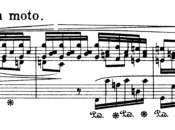Analysis
Contents
Presto
Form: Scherzo. Bb Minor.
SCHERZO (Bars 1-264):
A:
Bars 1-24: Theme 1, B flat minor. Modulates to D flat major (relative major) in Bars 13-17, then returns abruptly to B flat minor in Bar 18, ending with an implied interrupted cadence (Bars 20-22, bass notes only). The striking chord in Bar 6 is an inversion of ii half-diminished seventh (a similar chord was also used at the start of the first Scherzo).
Bars 25-48: Theme 1 restated. Begins in B flat minor as before (Bars 25-36), but then modulates to F minor (dominant) instead of D flat major in Bars 37-48.
Bars 49-64: Theme 2, all in D flat major, with some use of the flattened sixth degree (B double flat) as part of a dominant minor ninth chord, or part of a chromatic scale.
Bars 65-117: Theme 3 (con anima). Begins in G flat major, then modulates to A flat major (Bars 73-80, making a sequence with Bars 65-72) and D flat major. There is a dominant pedal in Bars 107-116, leading to a perfect cadence in Bars 116-117. A diminished seventh chord (F – A flat – C flat – D) is used in Bar 87, 103, and 109-112. Suspensions and appoggiaturas are used throughout this passage for added expressiveness (e.g. the G flat in Bar 69, E natural in Bar 97, etc.).
Bars 117-132: Closing theme – tonic and dominant seventh arpeggios in D flat major.
REPEAT OF A:
Bars 133-264: A repeat of Bars 1-132, with small rhythmic changes to Theme 1
TRIO (Bars 265-583):
B:
Bars 265-284: Theme 4. Begins in A major (D flat, the previous keynote, now becomes C sharp by an enharmonic change – the third of A major). Modulates to F sharp minor in Bars 277-284, with an imperfect cadence in Bars 280-281, followed by delicatissimo arpeggiation of the dominant chord.
Bars 285-308: Theme 4 restated. Begins in A major as before (Bars 285-298), then modulates to C sharp minor from Bar 299, with an imperfect cadence in Bars 305-306, followed by arpeggiation of the dominant chord.
Bars 309-333: Theme 5 (espressivo). Begins in C sharp minor. Modulates to F sharp minor (Bars 317-325, making a sequence with Bars 308-316), then returns to C sharp minor until the last two bars (Bars 332-333), which are in E major.
Bars 334-365: Theme 6 (leggiero). All in E major, with some use of the ii half diminished seventh chord (Bars 352-353 and 356-357).
REPEAT OF B:
Bars 366-367: A repeat of Bars 265-365, with small changes to the embellishment of Theme 4, and one additional bar (Bar 374).
DEVELOPMENT:
Bars 468-491: A continuation of Theme 6, passing through A minor (Bars 468-475), F sharp major (Bars 476-483), and G major (Bars 484-491), without settling in any of these keys.
Bars 492-515: Theme 5, G minor (Bars 492-498), C minor (Bars 499-506), and A flat minor (Bars 507-515).
Bars 516-543: Return of Theme 2 (from Section A), in E major (Bars 516-527), then rising sequentially through F sharp minor (Bars 528-531), G sharp minor (Bars 532-535) and B flat minor.
Bars 544-583: Theme 5 (sempre con fuoco), all in B flat minor. Melodically altered in Bar 545, 547, etc. Continually returns to the dominant chord in Bars 560-683, building expectation for the return of the opening material. Notice the similarity between Bar 578 (end of Theme 5) and Bar 584 (start of Theme 1), both of which use triplet rhythms and similar intervals, making the return of Theme 1 feel seamless.
SCHERZO (A) (Bars 584-715):
Bars 584-715: Similar to Bars 1-124, with an additional left hand trill (Bar 630), small changes in rhythm and texture in Bar 684. There is an extended passage of cadential preparation in Bars 701-707, with a dominant pedal in the bass, many diminished seventh chords, and a dominant minor ninth chord in Bar 707, leading to a perfect cadence in Bars 707-708.
CODA (Bars 716-780):
Bars 716-723: Coda. Begins with a modification of Theme 2 in the quite unexpected key of A major (Bars 716-723), using some chromatic notes a semitone above or below the dominant note.
Bars 724-732: The rhythm of Theme 2 continues in B flat minor, then moving chromatically in Bars 727-731 to D flat major.
Bars 733-756: Theme 1, D flat major, with some chromaticism, particularly during the stretto before the perfect cadence in Bars 755-756.
Bars 756-780: Theme 2, D flat major, with some chromatic notes a semitone above or below the dominant note, and a brief suggestion of F major in Bars 772-774, ends with a perfect cadence in Bars 775-776.







